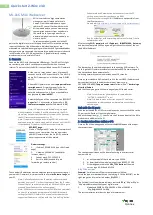
Chapter 3. Configuring your server
21
Notes:
1. The Advanced Appliance Configuration Utility configures and reports the
TCP/IP settings of the first adapter on each appliance server only. The first
adapter is typically the built-in Ethernet controller. Be sure to connect the built-in
Ethernet connector to the same physical network as your systems management
console.
2. The Advanced Appliance Configuration Utility must be running to configure
newly installed appliance servers automatically.
3. The system that is running the Advanced Appliance Configuration Utility console
automatically maintains a copy of its database (ServerConfiguration.dat) in the
Advanced Appliance Configuration Station installation directory. To remove
previous configuration data, close the Advanced Appliance Configuration Utility,
delete this file, and then restart the utility. This deletes all previously configured
families. However, the Advanced Appliance Configuration Utility will discover
connected appliance servers and their network settings.
The Advanced Appliance Configuration Utility agent
When your appliance is connected to your network, the Advanced Appliance
Configuration Utility agent automatically reports the MAC address for the appliance
(of the first NIC only), serial number, type of appliance, and whether DHCP in use by
the appliance. Furthermore, it will report the host name, primary IP address, subnet
mask, primary DNS address, and primary gateway address if these are configured on
the system.
The Advanced Appliance Configuration Utility agent is preinstalled on your IBM
xSeries appliance server.
Note:
The Advanced Appliance Configuration Utility agent periodically broadcasts
the appliance server IP settings. To prevent the service from broadcasting this
data periodically, stop the Advanced Appliance Configuration Utility service.
The IBM Advanced Appliance Configuration Utility
console
The Advanced Appliance Configuration Utility console is a Java application that you
install on one system in your network that will be used as a systems-management
console. For information on how to install the Advanced Appliance Configuration
Utility console, see “Using the Supplementary CD” on page 32.
Note:
Do not install the Advanced Appliance Configuration Utility console on more
than one systems-management console.
The Advanced Appliance Configuration Utility console enables you to:
•
Automatically discover appliance servers that run the Advanced Appliance
Configuration Utility agent and are attached to the same physical subnet as the
Advanced Appliance Configuration Utility console.
When you start the Advanced Appliance Configuration Utility console, it
automatically detects all appliance servers on your physical subnet that are
running the Advanced Appliance Configuration Utility agent.
•
Use a simple, GUI-based application to configure the network settings of the
appliance servers.
Use the Advanced Appliance Configuration Utility to assign IP addresses, DNS
and gateway server addresses, subnet masks, host names, and more.
•
Automatically group discovered appliances into function-specific families.
Summary of Contents for eServer xSeries 135
Page 1: ...User s Reference xSeries 135...
Page 2: ......
Page 3: ...IBM IBM xSeries 135 User s Reference...
Page 20: ...8 IBM xSeries 135 User s Reference...
Page 143: ......
Page 144: ...IBM Part Number 24P2803 24P28 3...
















































